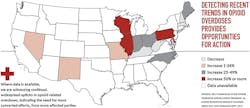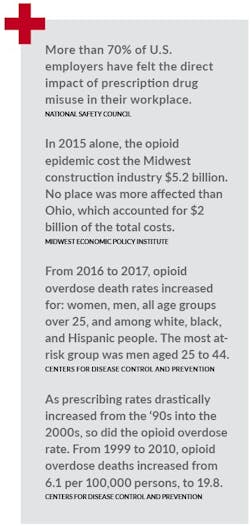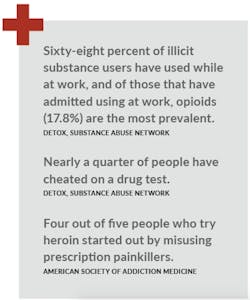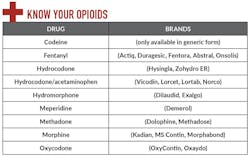Opioids are the country’s deadliest drug, and ending the epidemic requires an effort equal in scale. In the third and final story of our series on opioids in remodeling, we consider the levels of effort taking place to combat the problem: How government and healthcare industry actions are changing how pain is viewed and treated; how remodeling associations are working to educate the industry; and how businesses can affect change at the ground level, improving employee wellness and their bottom line.
The opioid epidemic has a massive damage radius. Since 1999, opioids and synthetic options, like fentanyl, have killed more Americans than died in World War II. It’s a problem that goes beyond any individual addict. It requires a national coalition, including every level of government and the entirety of the healthcare industry. Somewhere in that coalition is the remodeling industry.
Seventy percent of businesses in the U.S. have felt the impact of prescription drug abuse in the workplace. For most, it was absenteeism, on-the-job drug use, and weakened performance. The remodeling industry sits on the front lines of the problem due to the job’s physical nature, and resulting increase in pain medication prescriptions.
It’s not a remodeler’s responsibility to solve the country’s opioid crisis, or even ensure that employees are protected. That’s too big an undertaking. But understanding the role of small businesses as a resource against addiction is important for employee well-being and good for the bottom line. The Midwest Economic Policy Institute estimated in 2015 that, in the Midwest, a worker with an untreated opioid abuse problem will lose a contractor $6,800 per year. Inversely, a worker in recovery annually saves the same contractor $2,400.
Yet before discussing solutions to the opioid epidemic, it’s important to examine how the problem began.
Pain in America
The mid-’90s saw the beginning of a movement to consider pain levels as a key part of wellness. The former head of the American Pain Society (APS), Dr. James Campbell, called for the measurement of pain as a new “vital sign,” with APS becoming staunch, vocal advocates of a better understanding of pain.
Pain scales like this became prominent in the mid-'90s as part of the "pain as a 5th vital sign" push. Assessing pain has sense become much more comprehensive and nuanced, but these early and still-in-use assessment tools represent a nationwide turn in how medical professionals viewed the importance of pain in health assessment.
In 1995, the Agency for Healthcare Research and Quality, another national organization, introduced its widely used Consumer Assessment of Healthcare Providers and Systems patient satisfaction survey. The questionnaire included “pain” as a key metric, and effectively created a motivator for not only physicians, but consumers, advocacy groups, insurance companies, and healthcare accreditation organizations to take pain more seriously.
Pain and addiction are not well taught in our schools. It’s been pretty evident for the last decade.
In 1999, the Veterans Health Administration (VHA) launched its “Pain as the 5th Vital Sign” initiative that, for the first time, required VHA facilities to practice pain assessment through practices like “pain scores,” and required providers to educate patients and families on the availability of those measures and the importance of pain.
The Genesis of a Crisis
First came Purdue Pharma’s 1995 introduction of an “addiction-resistant” painkiller, OxyContin. The company launched “Oxy” with a blitzkrieg marketing campaign that flooded the country with opioids. By 2000, Oxy was the No. 1 most abused opioid, according to a study from the Washington University School of Medicine.
The second underlying problem was widespread ignorance of pain and addiction on the part of physicians.
It’s in these problems that we see the other side of the national fight against opioids: the legal and education battles.
A National Effort ... and Failure
The largest maneuvers in the war on opioid addiction are implemented by federal and state governments through legislation and legal rulings. The nation’s healthcare apparatus plays a major role as well with new data, internal reforms, and implementation of improved guidelines. It’s a statement on the significance of the opioid problem, and the difficulty in combating it, that the issue remains a perennial national agenda item.
In 2001, Congress commenced the “Decade of Pain Control and Research,” looking at the growing opioid problem as a failure of policy, education, ethics, and law. The decade capped off with the 2010 Affordable Care Act—which expanded pain treatment options and directed the Department of Health and Human Services to address pain as a public issue, and required insurance companies to cover substance-use treatment.
But over the course of the “Decade of Pain Control and Research,” opioid prescription rates more than tripled, to 81 per 100 persons. Annual deaths from opioids rose from about 10K to over 20K. Today, that figure has more than quadrupled, and opioids and synthetic opioids now account for two-thirds of all drug-related deaths. The federal government didn’t widely influence prescribing standards until 2016, when the Centers for Disease Control and Prevention released its Guideline for Prescribing Opioids for Chronic Pain. Until then, it had been influencing in piecemeal how pain and addiction is treated.
Legal Oversight
In the early 2000s, Congress and the Justice Department began taking action against the most prolific perpetrators (such as Purdue Pharma) of too-aggressive and sometimes-false marketing of painkillers. That company funded over 20,000 pain-related “educational” programs to sell OxyContin.
In 2007, Purdue Pharma executives were compelled to testify to the firm’s misleading claims about OxyContin’s addiction resistance—which turned out not have been rooted in any actual science—leading to the company and three of its execs, including its president, being found guilty in federal court of criminal charges of misleading regulators, doctors, and patients. Still to this day, U.S. courts are issuing rulings in direct response to the sometimes-too-aggressive influence of pharmaceutical companies.
Since 1999, opioids and synthetic opioids have killed more Americans than died in World War II.
In November 2019, Oklahoma Judge Thad Balkman ordered drugmaker Johnson & Johnson to pay the state $465 million for causing an “opioid crisis that is evidenced by increased rates of addiction, overdose deaths, and neonatal abstinence syndrome in Oklahoma,” the judge stated.
Education Improvement
Until fairly recently, there has been little emphasis on prioritizing a physician’s understanding of pain and addiction—which is why physicians are generally not experts.
“Pain and addiction are not well taught in our schools. It’s been pretty evident for the last decade,” says Melissa Weimer, a pain and addiction specialist and a professor at Yale University. It’s why doctors often don’t think to prep patients on things like the difference between addiction and dependency, she says, or explain how to effectively stop taking opioids.
“The medical education system has been focused on heart disease and cancer, both really important illnesses. But pain and addiction, for whatever reason, have always been seemingly less important.”
Joe Tlustos, an addiction coach with peer-recovery service Face It Together, has seen this shortage first hand. He says that in Sioux Falls, S.D., where he helps addicts achieve recovery, there are only two clinics with opioid rehab services that can administer methadone (used to treat narcotic drug addiction); often, they’re so booked patients have to wait weeks before getting treatment.
“A week to an addict who wants to change could be the difference between getting clean and slipping back into the abuse routine,” Tlustos says. “And when you’re a heavy user, trying to get clean without medical assistance can literally kill you.”
In its role as resource for the medical education community, Congress has taken action to bolster funding. The SUPPORT for Patients and Communities Act, introduced in 2018, and the Mental and Substance Use Disorders Workforce Training Demonstration Program, authorized in 2016, both aim to fund the expansion of addiction and pain medicine, to hopefully satisfy the overwhelming need for pain specialists in the country.
States in recent years have joined the effort to curb their own rising opioid crises as well. In 2018, Tennessee passed a comprehensive opioid reform program called “TN Together,” that focuses on improving prevention. And that same year, Pennsylvania’s House of Representatives passed an opioid-related resolution that directly called out the construction industry, declaring the last week in July “Construction Opioid Awareness Week.” This came after the governor had declared the epidemic a “statewide disaster emergency.”
Association Assistance
Opioid prescription rates have fallen since 2010, from 86 prescriptions per 100 people, to 62. It’s evidence that wider, institutional efforts are affecting the crisis overall. Still, prescription rates are three times what they were in 1999, and opioids kill more than 47,000 people annually. It’s that fact that emphasizes the importance and potential impact remodelers and industry institutions can have on the opioid epidemic within their respective spheres of influence. Because it’s remodelers that can help real individuals. And it’s industry associations that can help remodelers.
The National Association of Home Builders and the National Association of the Remodeling Industry both actively promote industry-wide opioid awareness, and consider it a responsibility.
Educating Remodelers
“We educate members on how they can address opioid concerns,” says David Jaffe, vice president of liability for NAHB, and the head of its Opioid Working Group. Associations such as NAHB and NARI, as well as more niche groups like the National Roofing Contractors Association (NRCA), serve as resource hubs and provide educational materials. NAHB specifically offers members and non-members alike access to downloadable toolkits that brief contractors on how to recognize, address, and ultimately prevent opioid abuse at the workplace, with pointers like “provide flexible paid time-off” and keep overdose reversal drugs like naloxone (branded Narcan) on hand.
Enlisting NAHB’s help is only a matter of reaching out, Jaffe says.
“A week to an addict who wants to change could be the difference between getting clean and slipping back into the abuse routine."
NARI CEO David Pekel, who prior to leading the association, worked for three decades as a remodeler, sees the association’s role in combating remodeling’s opioid problem as that of educator.
“We provide resources and help our members in creating a business environment that reduces the risk of opioid addiction,” he says. “We can help with things like setting up an employee assistance program.” But the first step, Pekel explains, is asking remodelers to take the Construction Coalition for a Drug- and Alcohol-Free Workplace (CCDAFW) pledge. It includes vowing to institute a drug testing policy, which studies show are at least somewhat effective in deterring workplace drug use.
Tailored Healthcare
Other associations, while also serving as educators, are angling to play a more active role. NRCA is currently working to offer members an avenue to a more affordable healthcare plan that specifically ensures better treatment options for addiction.
“It will focus on issues unique to the roofing industry, and the opioid problem is one of the things we’ve highlighted as needing to be covered smartly. For instance, our plan will restrict the amount of narcotics that can be prescribed by an in-network doctor at one time, which has been on the rise.”
Between 2006 and 2015, the average days’ supply of opioids prescribed increased 33%, from 13 to 18 days.
Remodeling’s most prominent associations are united in recognizing the deep impact the opioid epidemic has had on the industry, and each feels a certain obligation to improve understanding about the issue.
“It’s a crisis and we need to act,” says Ribble.
Better Healthcare, Better Business
Remodelers have a basic obligation to care for employees. They are responsible, as Rachael Cooper from the National Safety Council puts it, “for keeping the workplace and the organization safe.” But they’re not responsible for curing addiction.
Still, as associations can assist remodelers, so can remodelers assist their employees. It’s the role they can serve in the overarching war on opioids, and that some already are.
Alternative Treatments
Power Home Remodeling Group, a $600-million-plus company operating across multiple states, is one business striving to build a better anti-opioid strategy. A key part of it is healthcare.
“We take a holistic approach to the opioid crisis, especially in regards to healthcare,” says Jennifer Carreon-Montes, Power’s director of human resources, who helps lead the company’s efforts in reducing the risk of opioid abuse. “We can’t rely on a prescription drug plan for pain. We have to carve out medical plans that effectively treat pain without pills. That includes things like offering assistance on acupuncture and reducing co-pays for chiropractic care.”
According to Yale’s Melissa Weimer, a “robust healthcare plan” is the best possible thing an employer can do to help its employees. “Preferably one with opioid treatment alternatives.” She mentions specifically chiropractic visits and substance use disorder treatments.
Time to Heal
Some cases of chronic pain require prolonged opioid treatment, but the best course is often a mix of physical therapy, chiropractic work, and less powerful, non-narcotic painkillers, like everyday aspirin. “In a lot of situations, opioids are actually the worst treatment option,” Weimer says. The conflict for remodelers and the workers they employ, however, is the industry’s culture of working as hard as you can, when you can.
It can lead to workers ignoring injuries.
A quarter of construction workers have experienced an unreported injury, according to the Center for Construction Research and Training. “Workers need proper healthcare and paid sick leave so they can properly heal from injuries,” says Carreon-Montes. But more than that, they need reassurance that if injured, or sick, they will have time to heal without having to sacrifice a paycheck.
“Even if a person has no more PTO or sick time left in the bank, we aren’t going to tell them it’s work with an injury or go without pay.” Power has organized its healthcare plan so that it can offer injured employees short-term disability for treatment, even when their available time off has run out.
There are smart pain management paths, and risky pain management paths. Understanding the most effective, least risky route of treatment—which usually doesn't include opioids—is important in making sure you and your employees aren't being unnecessarily exposed to opioids.
Letting the Conversation Happen
Drugs and the workplace are a pretty tight pair. Addiction treatment provider Detox found in a survey of over 1,000 people that nearly 70% of respondents who’ve used illicit substances have done so in the workplace. More than half have done drugs with coworkers, and 42% say they’ve gotten drugs from coworkers.
It’s a problem with a prevalence that doesn’t match the conversation around it. “There is absolutely a stigma around drug addiction,” says Joe Tlustos. He gives the analogy of a cancer diagnosis at work. “You reveal to people in your office that you have cancer, and they’ll probably throw you a fundraiser,” he says. “Tell them you have a drug addiction and you’re reviled, like you’re a bad person because you’ve succumbed to it.”
Destigmatize
Curtis Morgan is a remodeler and recovering addict. He uses his Texas home improvement company, Precision Coil and Specialty, to give other recovering addicts a second chance. Morgan says that -communication is key to rooting out the problem, and remodelers are well positioned to start that conversation.
“We talk everyday about recovery,” Morgan says. One of his foremen, Austin Donalson, spent more than a decade addicted to opioids, and credits those conversations for helping keep his sobriety. “It’s beneficial for me because it’s just a stark reminder of where I came from,” says Donalson.
Through destigmatizing addiction and treating it more as a sickness, Morgan, Donalson, and the entire Precision team allow people struggling with a current addiction, or what they think could become one, to more comfortably share those struggles, and therefore seek help before it becomes any worse.
It’s an approach Power has also adopted as part of its anti-opioid strategy. The company’s efforts to destigmatize include educating managers and employees on the realities of drug addiction, as well as executives sharing their own addiction experiences as a way of broaching the conversation company-wide. “During a cultural inclusion conference we hold every year, a VP shared his struggle with addiction,” says Carreon-Montes. “It inspired other employees to then stand up and share theirs as well.”
Employee Assistance Program
Power is also planning this year to implement an employee assistance program (EAP)—which NARI, NAHB, and NRCA all recommend, as well as Weimer, the National Safety Council, and HHS’s Substance Abuse and Mental Health Services Administration.
EAPs can be run through a business or through third parties, like ESI Employee Assistance Group. Cooper, though, recommends remodelers try to avoid, if possible, building EAPs in-house. “If you have an EAP onsite, it’s hard to ensure the information will stay confidential, and that can dissuade some people from seeking help.” She suggests third-party providers that can be reached through the phone. “If a supervisor suspects an issue, they can give an employee a phone number to call for help, and then they’re out of the process.”
About the Author

James F. McClister
James McClister is managing editor for Professional Remodeler.







